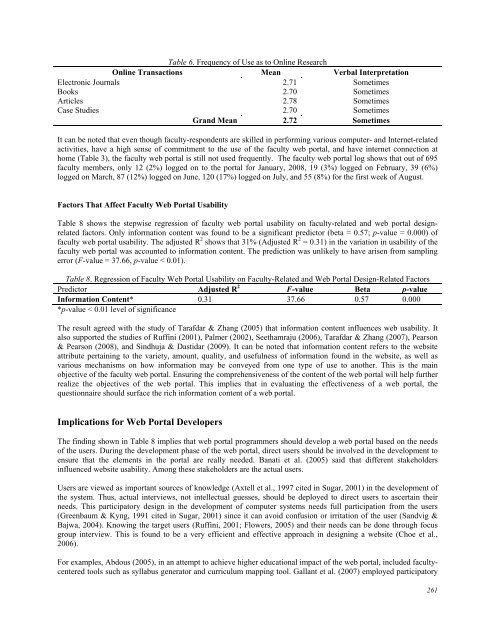October 2011 Volume 14 Number 4 - Educational Technology ...
October 2011 Volume 14 Number 4 - Educational Technology ...
October 2011 Volume 14 Number 4 - Educational Technology ...
Create successful ePaper yourself
Turn your PDF publications into a flip-book with our unique Google optimized e-Paper software.
Table 6. Frequency of Use as to Online Research<br />
Online Transactions Mean Verbal Interpretation<br />
Electronic Journals 2.71 Sometimes<br />
Books 2.70 Sometimes<br />
Articles 2.78 Sometimes<br />
Case Studies 2.70 Sometimes<br />
Grand Mean 2.72 Sometimes<br />
It can be noted that even though faculty-respondents are skilled in performing various computer- and Internet-related<br />
activities, have a high sense of commitment to the use of the faculty web portal, and have internet connection at<br />
home (Table 3), the faculty web portal is still not used frequently. The faculty web portal log shows that out of 695<br />
faculty members, only 12 (2%) logged on to the portal for January, 2008, 19 (3%) logged on February, 39 (6%)<br />
logged on March, 87 (12%) logged on June, 120 (17%) logged on July, and 55 (8%) for the first week of August.<br />
Factors That Affect Faculty Web Portal Usability<br />
Table 8 shows the stepwise regression of faculty web portal usability on faculty-related and web portal designrelated<br />
factors. Only information content was found to be a significant predictor (beta = 0.57; p-value = 0.000) of<br />
faculty web portal usability. The adjusted R 2 shows that 31% (Adjusted R 2 = 0.31) in the variation in usability of the<br />
faculty web portal was accounted to information content. The prediction was unlikely to have arisen from sampling<br />
error (F-value = 37.66, p-value < 0.01).<br />
Table 8. Regression of Faculty Web Portal Usability on Faculty-Related and Web Portal Design-Related Factors<br />
Predictor Adjusted R 2 F-value Beta p-value<br />
Information Content* 0.31 37.66 0.57 0.000<br />
*p-value < 0.01 level of significance<br />
The result agreed with the study of Tarafdar & Zhang (2005) that information content influences web usability. It<br />
also supported the studies of Ruffini (2001), Palmer (2002), Seethamraju (2006), Tarafdar & Zhang (2007), Pearson<br />
& Pearson (2008), and Sindhuja & Dastidar (2009). It can be noted that information content refers to the website<br />
attribute pertaining to the variety, amount, quality, and usefulness of information found in the website, as well as<br />
various mechanisms on how information may be conveyed from one type of use to another. This is the main<br />
objective of the faculty web portal. Ensuring the comprehensiveness of the content of the web portal will help further<br />
realize the objectives of the web portal. This implies that in evaluating the effectiveness of a web portal, the<br />
questionnaire should surface the rich information content of a web portal.<br />
Implications for Web Portal Developers<br />
The finding shown in Table 8 implies that web portal programmers should develop a web portal based on the needs<br />
of the users. During the development phase of the web portal, direct users should be involved in the development to<br />
ensure that the elements in the portal are really needed. Banati et al. (2005) said that different stakeholders<br />
influenced website usability. Among these stakeholders are the actual users.<br />
Users are viewed as important sources of knowledge (Axtell et al., 1997 cited in Sugar, 2001) in the development of<br />
the system. Thus, actual interviews, not intellectual guesses, should be deployed to direct users to ascertain their<br />
needs. This participatory design in the development of computer systems needs full participation from the users<br />
(Greenbaum & Kyng, 1991 cited in Sugar, 2001) since it can avoid confusion or irritation of the user (Sandvig &<br />
Bajwa, 2004). Knowing the target users (Ruffini, 2001; Flowers, 2005) and their needs can be done through focus<br />
group interview. This is found to be a very efficient and effective approach in designing a website (Choe et al.,<br />
2006).<br />
For examples, Abdous (2005), in an attempt to achieve higher educational impact of the web portal, included facultycentered<br />
tools such as syllabus generator and curriculum mapping tool. Gallant et al. (2007) employed participatory<br />
261

















